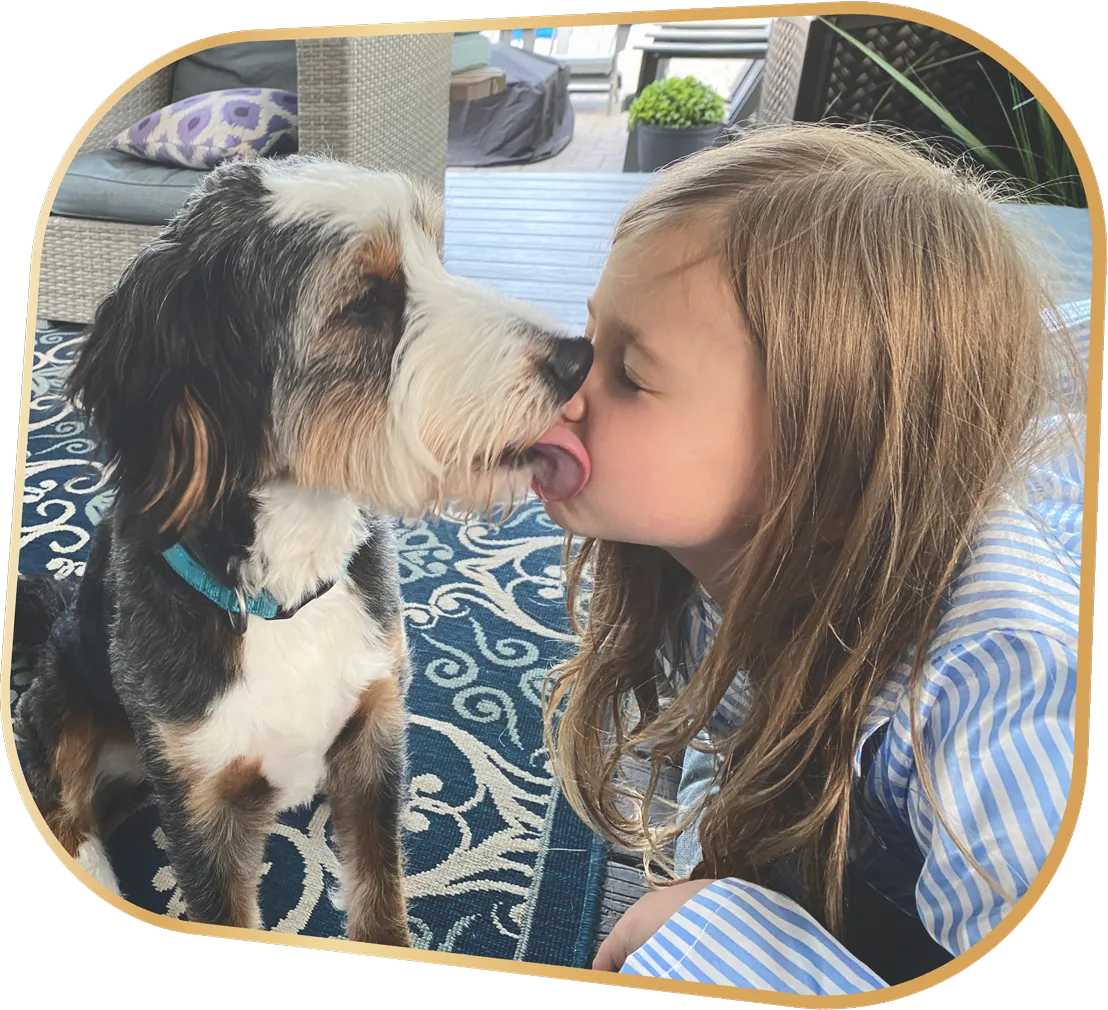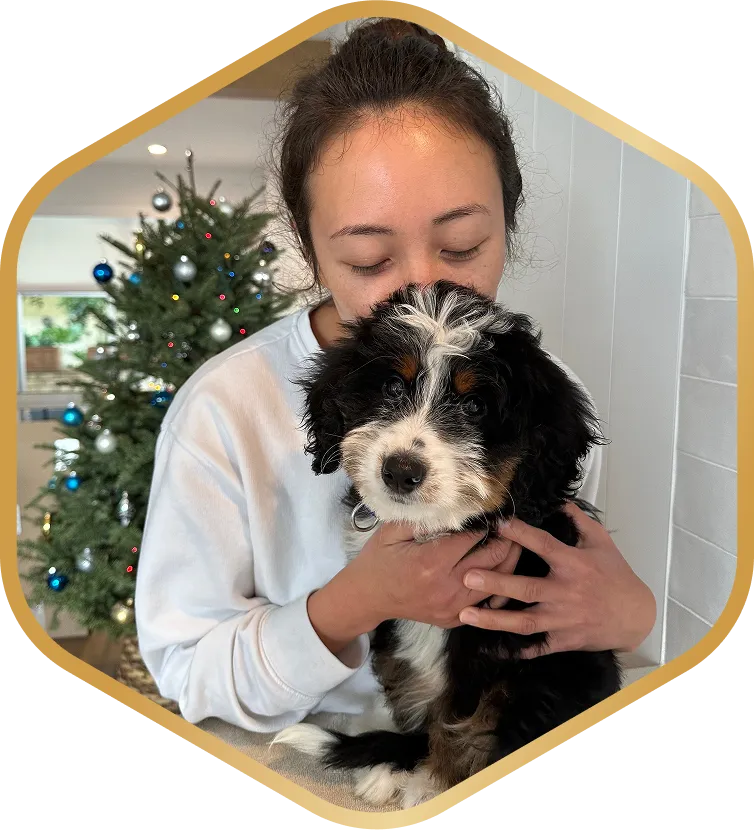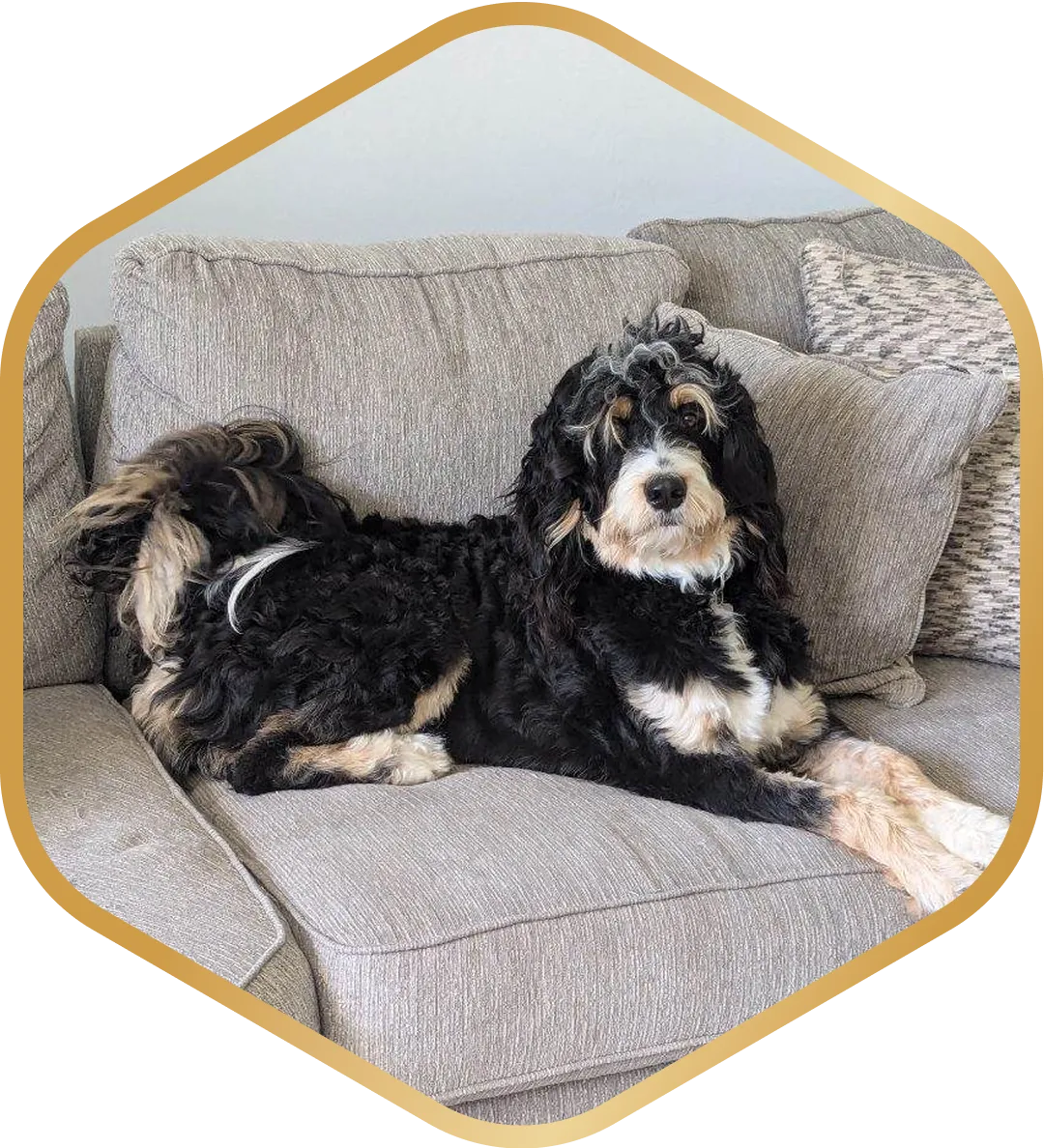Meet the adorable Bernedoodle puppy: a designer dog breed that’s the wonderful cross between a Bernese Mountain Dog and a Poodle.
While Bernedoodles have only been around since the early 2000s, they have quickly become a popular choice for many families—and for good reason! Combining the intelligent, sensitive poodle and the calm, friendly Bernese Mountain Dog creates a smart, loyal, and playful companion for homes of all types. Anyone seeking out a Bernedoodle puppy can look forward to one of the finest designer dogs ever bred.
Want to learn more? Keep reading!



Bernese Mountain Dogs nearly went extinct in the late 1800s. In an effort to bring them back, inbreeding caused various health issues, including a relatively short lifespan (6–8 years). Crossing the Bernese with a poodle passes down the Bernese’s amazing social qualities while increasing their lifespan to 14–17 years! If you like the loyal, easy-going nature of the Bernese, but want something with even more intelligence, minimal to no shedding (making them moderately hypoallergenic), and better health and longevity, look no further. You have found it in the Bernedoodle!
Our bernedoodles tend to be well balanced dogs. They are usually extremely smart with a friendly, sociable, and playful disposition that is a good fit for owners of any experience level.
First-time owners may want to consider obedience classes. Bernedoodles tend to be very trainable. Training provides a wonderful bonding experience with your dog. Get started while they’re young and your pup will enjoy your family, friends, and other pets for a lifetime.
For those that choose to personally train their dog, we recommend an online training program that we've found to be very helpful. Read more on that here.

At Walnut Valley, we breed the following varieties of Bernedoodles—each with its own unique advantages. You’re sure to find the perfect fit for your home!
We are often asked if there are differences between male and female Bernedoodle personalities. While there may be slight differences, they are actually quite subtle. Both males and females make absolutely amazing pets, and in most cases it is a matter of preference.
What truly matters is choosing a puppy with a temperament that matches your home—something that can vary more between puppies of the same litter than any noticeable difference in sex.
Because of this, we take the time to get to know you and your puppy before bringing them home—so you’re sure to find the perfect match!

Coat colors are generally a combination of both of the parents' breeds. At Walnut Valley Puppies, we specialize in maintaining the beautiful tri-color marking of the Bernese Mountain Dog while adding the hypoallergenic properties of the poodle.
Here’s a bit about our bernedoodles:


Curly Bernedoodle coat types shed the least and are the most hypoallergenic of the three types. The curls on this coat are usually tight with a soft texture, much like what you would see on a Poodle. While they lose a minimal amount of hair, they do need to be brushed and groomed regularly. The curly coat is the best choice for owners with an allergy to dog dander.



The wavy Bernedoodle coat type—one that’s free-flowing and with a slightly kinked or wavy look—is also low- to non-shedding. This is the coat most seen on Bernedoodles. Owners with allergies to dog dander will usually be fine with a wavy-coated dog. If you’re uncertain about the severity of your allergies, try to find doodles in your area to interact with. You can also get further allergy testing from a medical professional.



Of the three Bernedoodle coat types, a straight-haired Bernedoodle coat tends to shed the most and be the least hypoallergenic. Even though this coat is called “straight” or flat, it may actually have a slight wave to it. This coat type is uncommon and most Bernedoodles are born with curly or wavy coats.


Many families adopt Bernedoodles because of their low- to no-shed hypoallergenic coats. While this is a huge advantage—especially for those allergic to dog dander—it should be noted that wavy and curly coats require regular grooming to maintain the health and comfort of your dog.
Curlier coats are prone to matting, tangles, and knots. When left ungroomed, these can lead to tight, sore skin for your pet. To keep your puppy happy, you’ll need to groom their coat (or make trips to the groomer) at recommended intervals of every 4-8 weeks. This keeps their coats shorter, more comfortable, and lower maintenance (longer, curlier coats require frequent brushing).
Additionally, grooming habits greatly affect the appearance of your Bernedoodle. Consider this when looking at pictures of prospective puppy choices. Here are several examples of how different the same dog can look before and after grooming!
Here are just a few more reasons to love Bernedoodles:

Due to their well-balanced temperament and high trainability, our Bernedoodles are often trained as therapy dogs—a job that allows them to thrive alongside humans while showing their cuddly and affectionate side!

Most Bernedoodles adapt well to apartment living, with a few caveats. Their Bernese lineage means they want plenty of attention and exercise to stay happy and healthy. They also love human interaction and don’t like to be left for extended periods of time (although they are fine with shorter breaks in attention).

Bernedoodles are true companion dogs. They are very intelligent and are often described as having a happy-go-lucky, goofy, and charming temperament. They are happiest when spending time with their families and enjoy playtime, affection, and cuddles in equal measure. These dogs are excellent around children and the elderly. They simply wants to love and be loved in return, which makes them a fantastic companion for single owners and for families.
These families are loving their new best friend. Let’s find the perfect match for your home.
You have two options for finding your puppy: reserving one of our available puppies or joining the reservation list for a puppy in an upcoming litter. Here’s how it works...
Check our listing of currently available Bernedoodle puppies to start looking for the perfect match.
Once you’ve found a puppy you love, give us a call or text to check availability, request videos, and get more information.
Place a deposit to reserve your puppy and we’ll begin the process of you taking them home.
Enjoy a loving, loyal, smart, and goofy companion for life—with lifetime support from a trusted breeder committed to your family’s happiness.
Join the reservation list by placing a $500 deposit here. Once your deposit is confirmed, you’re placed on the list on a first come, first served basis.
When new litters arive, we’ll contact you and provide the option to potentially choose a puppy or wait for a subsequent litter.
When the pupies are five weeks old, you will pick your puppy on a first come, first served basis. More details here.
Enjoy a loving, loyal, smart, and goofy companion for life—with lifetime support from a trusted breeder committed to your family’s happiness.
Join the reservation list to be notified of all future litters and available puppies. There’s never an obligation to adopt, you can pass on as many litters as you like, and you only move up in priority as time goes on!
Join the reservation list
Here are some of the most common questions we get asked about bringing home a new puppy. For a full list of FAQs, visit our FAQ page. And of course, we’re always happy to chat—so give us a call!
To ensure the health of your new pet, we recommend pawTree dog food to all of our adoptive pet owners. In our opinion, pawTree sells the best dog food and supplements on the market. It’s what we feed our growing puppies before they’re adopted, and a key ingredient to our 5-Year Genetic Health Guarantee. And since we believe in pawTree foods and products so much, we’ve extended our Genetic Health Guarantee to 5 full years if you feed pawTree dog foods during that time.
Here’s a bit more of what you can expect by feeding pawTree:
Plus, pawTree stands behind their products with a 90 day money back (no return necessary) satisfaction guarantee and promise to make any issues right if you aren’t absolutely satisfied—making your first order a no-brainer.
Learn more about pawTree food and and get a 20% discount on your first order.
An F1B Micro Bernedoodle is a second-generation cross between an F1 Mini Bernedoodle and a Toy Poodle.
This means you get a puppy that's 25% Bernese for a sweet, gentle nature and 75% Poodle for intelligence and that desirable low-shedding coat. Being 75% Poodle, the F1B Micro Bernedoodle are the most hypoallergenic bernedoodle of our varieties.
F1B Micro Bernedoodles typically mature to an adorable size of 10-25 lbs. and have a long lifespan of 15-18 years, making them perfect for families seeking a smaller breed.
F1B Micro Bernedoodles lifespan is typically between 14 and 18 years.
Due to the inbreeding that took place to bring the Bernese Mountain Dog back into population from the brink of extinction, Bernese Mountain Dogs are vulnerable to several genetic disorders and often have short lifespans. Due to the long lifespan of the miniature poodle genetics, F1B Micro and F1B Mini Bernedoodles have a lifespan of 14-18 years.
Of course, other factors such as genetics, diet, and overall care influence the life expectancy of a Bernedoodle.
At Walnut Valley Puppies, all of our parent dogs are health-tested prior to breeding, enabling us to guarantee the genetic health of our puppies with our 5-Year Genetic Health Guarantee!
To learn more about how we test our dogs and about our 5-Year Genetic Health Guarantee, check our Health Guarantee page!
An F1B Tiny Bernedoodle is the result of breeding an F1 Mini Bernedoodle to a Miniature Poodle. F1B Tiny Bernedoodles usually stand between 12 and 17 inches tall and weigh between 15 and 25 pounds. Again, these puppies tend to be more hypoallergenic and usually less shedding than the F1 Bernedoodles.
Yes, F1B Micro Bernedoodles are considered a hypoallergenic breed. However, there is no such thing as a fully hypoallergenic dog, as people can also be allergic to dog saliva or urine, etc. For those with mild to medium pet allergies, F1B Micro Bernedoodles make a wonderful addition to the family, as they are usually low shed to no shed.
For a person with severe allergies, we want to ensure that the puppy you take home has as curly a coat as possible. F1B Bernedoodles usually have the most curly coats, they usually are compatible for those with more severe allergy problems. If you have concerns, we suggest that you get further allergy testing done as well as take some time to interact with doodles and their humans in your area before purchasing a puppy.